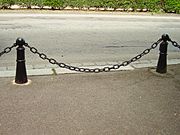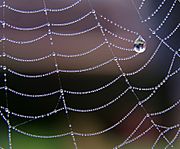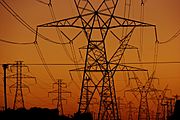Catenary facts for kids
In physics and geometry, a catenary is the curve that an idealized hanging chain or cable assumes under its own weight when supported only at its ends. The curve has a U-like shape, superficially similar in appearance to a parabola, but it is not a parabola: it is a (scaled, rotated) graph of the hyperbolic cosine. The curve appears in the design of certain types of arches and as a cross section of the catenoid—the shape assumed by a soap film bounded by two parallel circular rings.
The catenary is also called the alysoid, chainette, or, particularly in the materials sciences, funicular.
Mathematically, the catenary curve is the graph of the hyperbolic cosine function. The surface of revolution of the catenary curve, the catenoid, is a minimal surface, specifically a minimal surface of revolution. The mathematical properties of the catenary curve were first studied by Robert Hooke in the 1670s, and its equation was derived by Leibniz, Huygens and Johann Bernoulli in 1691.
Catenaries and related curves are used in architecture and engineering, in the design of bridges and arches, so that forces do not result in bending moments. In the offshore oil and gas industry, "catenary" refers to a steel catenary riser, a pipeline suspended between a production platform and the seabed that adopts an approximate catenary shape. The word "catenary" comes from the Latin word catena, which means "chain". A catenary is also called called an alysoid and a chainette.
Images for kids
-
Antoni Gaudí's catenary model at Casa Milà
-
Simple suspension bridges are essentially thickened cables, and follow a catenary curve.
-
Stressed ribbon bridges, like the Leonel Viera Bridge in Maldonado, Uruguay, also follow a catenary curve, with cables embedded in a rigid deck.
-
A heavy anchor chain forms a catenary, with a low angle of pull on the anchor.
-
Golden Gate Bridge. Most suspension bridge cables follow a parabolic, not a catenary curve, because the roadway is much heavier than the cable.
-
The Sheffield Winter Garden is enclosed by a series of catenary arches.
-
The Gateway Arch (St. Louis, Missouri) is a flattened catenary.
See also
 In Spanish: Catenaria para niños
In Spanish: Catenaria para niños












